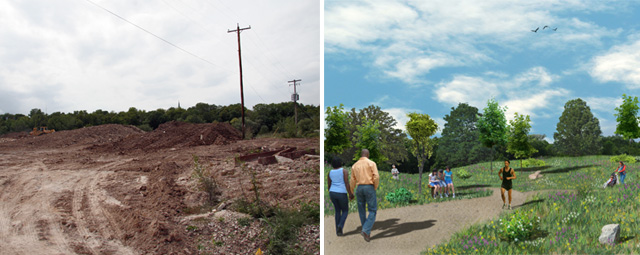How Olmsted Helped Shape the East Side
Drawing inspiration from romantic, well manicured English gardens and the promenade of Paris’ Champs-Élysées, Olmsted’s landscape style was decidedly more formal than the sustainable approach that dominates public spaces today. Still, Olmsted’s influence on Milwaukee’s East Side community is undeniable. One hundred twenty five years later, our vibrant community molds to meet modern needs while still operating around the bones of Olmsted’s original plan.

Depicted on a postcard, this image of Newberry Boulevard from shortly after its construction was used to promote the city of Milwaukee and its beauty. Source: www.rspna.org
Spaces of Contradiction
Affectionately dubbed Milwaukee’s “emerald necklace,” the Milwaukee County Park System has been touted as one of the best park systems in the nation. It is no coincidence, however, that the majority of our total county park acreage is concentrated near the edge of Milwaukee city limits. This urban planning strategy provided (and some would argue continues to provide) a natural buffer between the city and the suburbs, a transition from urban density to suburban sprawl.
This approach was just another example of the all too common way urban spaces were used to divide communities instead of bringing them together. Roads, rail lines, and yes, parks have all historically been used to manipulate public space and control the flow of citizens within that space. So, why are Olmsted-designed parks special? Well, because Olmsted envisioned a space where:
“…all classes [are] largely represented, with a common purpose… each individual adding by his mere presence to the pleasure of all others, all helping to the greater happiness of each. You may thus often see vast numbers of persons brought closely together, poor and rich, young and old, Jew and Gentile.” - excerpt from “Public Parks and the Enlargement of Towns” by Frederick Law Olmsted, published by the American Social Science Association, 1870
As flowery and politically incorrect as Olmsted’s century old language might be, he gets at the heart of the Urban Ecology Center’s focus today: bringing together those who might not otherwise have access to nature and offering a public resource for respite and recreation, both amidst and removed from the bustle of the city.

This scenic image, another postcard from around the turn of the century, portrays the grandeur of recreation on the Milwaukee river. Source: http://wisconsinproject.blogspot.com
River(side) Park
While the Riverside Park of today looks very little like the River Park Olmsted envisioned, it is remarkable how little the way we use the space has changed. Teachers and their students still congregate in the park, the experience magnified as enthusiastic Urban Ecology Center staff use the space as an outdoor classroom. Milwaukee citizens still enjoy the outdoors while floating down the Milwaukee River, only now in canoes and kayaks instead of the rowboats of Olmsted’s time. Sure, we look different while doing these activities – sporting rain ponchos instead of petticoats and baseball caps instead of top hats – but the experience remains much the same.
Even today the re-imagining of Olmstead’s egalitarian vision continues with the evolution of Riverside Park and its incorporation into the Rotary Centennial Arboretum, opening September 28th. Once complete the Arboretum will total forty acres, including six acres of restored industrial land, and will serve as a public park, outdoor classroom, and collection of trees, plants, and habitat native to southeast Wisconsin.

Before and after: the former industrial site on the Arboretum parcel, and a rendering of the same site after restoration and five years of growth. Rendering by Amanda Kingsbury
I invite you to come visit the East Side and see for yourself how Olmsted’s blueprint is still at work. Stroll along Lake Park and take in the scenic vistas of Lake Michigan as Olmstead intended. Bike down Newberry Boulevard, marveling at the varying architectural styles represented in its grand residences. And upon reaching the intersection of Newberry and Oakland Avenue, cross over into Riverside Park and witness Olmsted’s vision re-imagined: a space that, under the direction of the Urban Ecology Center, cultivates innovation in environmental education, land stewardship, and community development. And with the addition of the Rotary Centennial Arboretum, our Milwaukee community will benefit from the opportunity to access even more geographic space in which to foster understanding and instill a love for nature and outdoor recreation.
I think Olmsted would approve, don’t you?
Sources:
“Public Parks and the Enlargement of Towns,” Frederick Law Olmsted
“Images of America: Milwaukee County Parks”, Laurie Muench Albano
“Urbanization,” Paul Knox and Linda McCarthy
Lake Park Friends
Project for Public Spaces
Riverside Park Neighborhood Association
The Wisconsin Project





